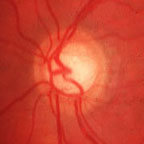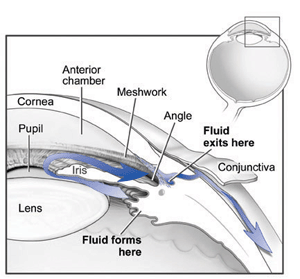WHAT IS GLAUCOMA?
 Glaucoma
is an eye disease that gradually steals your vision. Often, glaucoma has no
symptoms and can result in vision loss. Without proper treatment, glaucoma
can lead to blindness. The good news is that with regular eye exams, early
detection, and treatment, you can preserve your sight.
Glaucoma
is an eye disease that gradually steals your vision. Often, glaucoma has no
symptoms and can result in vision loss. Without proper treatment, glaucoma
can lead to blindness. The good news is that with regular eye exams, early
detection, and treatment, you can preserve your sight.
Glaucoma refers to a group of eye disease that have common features including eye pressure too high for the health of the eye, damage to the optic nerve, and permanent loss of sight. Although most people with glaucoma don’t lose their sight, glaucoma is still a leading cause of blindness in the United States.
How the Eye Works
To understand glaucoma, you must first understand how the eye works. This picture will help you identify the important parts of your eye. A tough white covering called the sclera protects the eye. Part of the white sclera can be seen in the front of the eye. A clear, delicate membrane called the conjunctiva covers the sclera.
 At
the front of the eye is the cornea. The cornea is the clear part of the eye’s
protective covering. It allows light to enter the eye. The iris is the colored
part of your eye that shrinks and expands so the pupil can let just the right
amount of light into the eye. The light is directed by the pupil to the lens.
The lens focuses the light onto the retina (the inside lining of the eye).
Nerve fibers in the retina carry light and images to the brain through the
optic nerve.
At
the front of the eye is the cornea. The cornea is the clear part of the eye’s
protective covering. It allows light to enter the eye. The iris is the colored
part of your eye that shrinks and expands so the pupil can let just the right
amount of light into the eye. The light is directed by the pupil to the lens.
The lens focuses the light onto the retina (the inside lining of the eye).
Nerve fibers in the retina carry light and images to the brain through the
optic nerve.
Healthy Drainage
The front part of the eye is filled with a clear fluid (called intraocular fluid or aqueous humor) made by the ciliary body. The fluid flows through the pupil. It is then absorbed into the bloodstream through the eye’s drainage system (a meshwork of drainage canals around the outer edge of the iris). Proper drainage helps keep eye pressure at a normal level. The production, flow, and drainage of this fluid is an active, continuous process that is needed for the health of the eye.
The inner pressure of the eye (intraocular pressure or IOP) depends on the amount of fluid in the eye. If you eye’s drainage system is working properly, then fluid can drain freely out and prevent a buildup. Likewise, if your eye’s fluid system is working properly, then the right amount of fluid can be produced for a health eye. Your IOP can vary at different times of the day, but it normally stays within a range that the eye can handle.
The Eye With Glaucoma
In most types of glaucoma, the eye’s drainage system becomes clogged so the intraocular fluid cannot drain. As the fluid builds up, it causes pressure to build inside the eye. High pressure damages the sensitive optic nerve and results in vision loss.
The Optic Disc
You have millions of nerve fibers in your retina that form the optic nerve. These fibers meet at the optic disc. As fluid pressure within your eye increases, it damages these sensitive nerve fibers and they begin to die. As they die, the disc begins to hollow and pushes the optic nerve into a cupped or curved shape. If the pressure remains too high for too long, the extra pressure can damage the optic nerve and result in vision loss.
Is There Another Cause?
It was once thought that high intraocular pressure (IOP) was the only cause of this optic nerve damage. Although IOP is clearly the biggest risk factor, we now know that other factors must also be involved because people with “normal” IOP can experience vision loss from glaucoma.
Will I Notice It?
Glaucoma usually occurs in both eyes, but extra fluid pressure often starts to build up in one eye first. This damage may cause gradual visual changes and then sight loss. Often, peripheral (side) vision is affected first, so the change in your vision may be small enough that you may not notice it. With time, your central (direct) vision will also begin to be lost.
Are There Symptoms?
In the most common form of glaucoma, buildup of fluid pressure happens very slowly. Often, there are no uncomfortable or painful symptoms.
In less common kinds of glaucoma, symptoms can be more severe. These symptoms can include:
- Hazy Vision
- Eye and head pain
- Nausea or vomiting
- The appearance of rainbow-colored circles around bright lights
- Sudden sight loss
*Information courtesy of Glaucoma Research Foundation and the National Eye Institute

